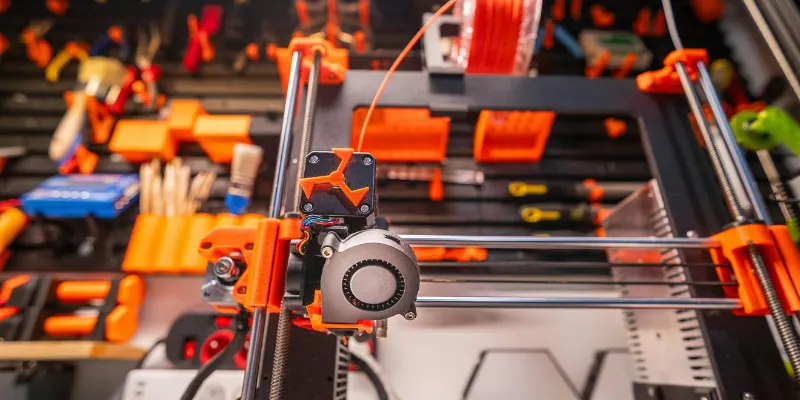3D Printers Create Your Dreams Layer by Layer
Published: 20 Apr 2025
Did you know that 3D printers can create everything from simple toys to complex medical implants? These incredible machines use layer-by-layer printing technology to turn digital designs into real objects. Once limited to industries, 3D printers are now affordable and accessible for hobbyists, students, and businesses. Whether you want to build prototypes, fix broken parts, or just have fun with DIY projects, 3D printing opens up endless possibilities. Let’s explore the 3D printers:
Introduction
A 3D printer is a machine that creates physical objects by building them layer by layer from digital designs. It uses materials like plastic, resin, or metal to form solid shapes based on a 3D model. This process, called additive manufacturing, is used in industries, education, and home projects to make prototypes, tools, and custom items.
Importance of 3D Printers?
- Faster Prototyping: Engineers and designers can test ideas quickly.
- Cost-Effective Manufacturing: Reduces the need for expensive molds and tools.
- Customization: Allows for unique, one-of-a-kind creations.
- Education & Learning: Helps students and hobbyists explore creativity and STEM skills.
- Medical Advancements: Used to create prosthetics, implants, and even organs.
- Reduced Waste: Uses only the material needed, making it eco-friendly.
- DIY and Repairs: Print missing parts, tools, or personalized items at home.

Types of 3D Printers
- Fused Deposition Modeling (FDM): Uses heated plastic filament to build objects layer by layer.
- Stereolithography (SLA): Uses liquid resin and UV light for high-detail prints.
- Digital Light Processing (DLP): Similar to SLA but uses a digital light projector for faster curing.
- Selective Laser Sintering (SLS): Uses a laser to fuse powdered material like plastic or metal.
- Selective Laser Melting (SLM): Melts metal powder to create strong, detailed metal parts.
- Electron Beam Melting (EBM): Uses an electron beam instead of a laser for high-strength metal printing.
- Binder Jetting: Deposits liquid binder onto powder layers to form objects, used in ceramics and metal printing.
- Material Jetting: Sprays tiny material droplets, similar to an inkjet printer, for high-precision prints.
Applications of 3D Printers
- Prototyping & Product Design: Engineers use 3D printing to create and test product models.
- Healthcare & Medicine: Used for prosthetics, implants, dental models, and even bio-printing tissues.
- Education & Research: Helps students and researchers visualize concepts and create models.
- Aerospace & Automotive: Produces lightweight, durable parts for aircraft and vehicles.
- Architecture & Construction: Creates detailed building models and even 3D-printed houses.
- Fashion & Jewelry: Enables custom designs for clothing, accessories, and jewelry.
- Manufacturing & Industry: Reduces production costs and allows for on-demand parts.
- DIY & Home Use: Hobbyists create tools, replacement parts, and creative projects.
- Food Industry: Used to print chocolates, pasta, and other edible designs.
- Entertainment & Art: Helps artists, filmmakers, and game designers bring digital creations to life.
| Advantages of 3D Printers |
|---|
|
| Disadvantages of 3D Printers |
|---|
|
A 3D printer is a machine that creates objects layer by layer using plastic, resin, or other materials. It follows a digital design file and prints in a process called additive manufacturing. This allows you to make anything from toys to tools at home!
The cost depends on the printer and materials. Beginner-friendly printers start at around $200, and basic filament is affordable. Over time, printing your own items can save money compared to buying custom-made products.
You can print phone stands, tools, toys, home décor, and even replacement parts for household items. Some people create jewelry, cosplay props, and custom prototypes. The possibilities are endless!
Most beginner printers use plastic filament like PLA or ABS. Resin printers use liquid resin, which is best for detailed models. The material you choose depends on what you want to print.
Not at all! If you start with simple projects and follow guides, you’ll pick it up quickly. With practice, you can move on to more advanced designs.
Small objects can take 30 minutes to a few hours, while larger prints may take several hours or even days. Print time depends on the object’s size, complexity, and the printer’s speed settings.
Yes, but it’s important to follow safety guidelines. Keep the printer in a well-ventilated area, especially when using ABS or resin, and avoid touching the heated parts. Supervise kids if they are using a 3D printer.
Yes! You can use free software like Tinkercad or Fusion 360 to design your own objects. If you’re not into designing, you can download free models from websites like Thingiverse.
Definitely! Many people sell custom prints, prototypes, or print-on-demand products. You can also offer services like 3D scanning or designing unique objects.
Online forums, YouTube tutorials, and manufacturer websites are great places for troubleshooting tips. Communities like Reddit’s r/3Dprinting or Facebook groups can help with common issues. Most problems have simple fixes!
Conclusion
So guys, in this article, we’ve covered 3D printers in detail. Whether you want to create art, gadgets, or prototypes, 3D printing gives you the power to turn ideas into reality. I personally love experimenting with resin printers for detailed models, but if you’re just starting, an FDM printer like the Ender 3 is a great choice. Take the first step today and start printing your own designs!

- Be Respectful
- Stay Relevant
- Stay Positive
- True Feedback
- Encourage Discussion
- Avoid Spamming
- No Fake News
- Don't Copy-Paste
- No Personal Attacks

- Be Respectful
- Stay Relevant
- Stay Positive
- True Feedback
- Encourage Discussion
- Avoid Spamming
- No Fake News
- Don't Copy-Paste
- No Personal Attacks
